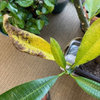Fertilizer Question
kimmiesplummies
12 years ago
Related Stories

GARDENING GUIDESGet on a Composting Kick (Hello, Free Fertilizer!)
Quit shelling out for pricey substitutes that aren’t even as good. Here’s how to give your soil the best while lightening your trash load
Full Story
SELLING YOUR HOUSE15 Questions to Ask When Interviewing a Real Estate Agent
Here’s what you should find out before selecting an agent to sell your home
Full Story
GARDENING GUIDESNo-Regret Plants: 5 Questions Smart Shoppers Ask
Quit wasting money and time at the garden center. This checklist will ensure that the plants you're eyeing will stick around in your yard
Full Story
GARDENING GUIDESHow to Keep Your Citrus Trees Well Fed and Healthy
Ripe for some citrus fertilizer know-how? This mini guide will help your lemon, orange and grapefruit trees flourish
Full Story
GARDENING GUIDESHow to Switch to an Organic Landscape Plan
Ditch the chemicals for a naturally beautiful lawn and garden, using living fertilizers and other nontoxic treatments
Full Story
GARDENING GUIDESCommon Myths That May Be Hurting Your Garden
Discover the truth about fertilizer, soil, staking and more to keep your plants healthy and happy
Full Story
EARTH DAYThe Case for Losing the Traditional Lawn
Work less, help the environment and foster connections by just saying no to typical turf
Full Story
EDIBLE GARDENSHow to Add an Apple Tree to Your Edible Garden
Readily available, beautiful and fragrant, apple trees offer four-season interest along with crisp, juicy fruit
Full Story
GARDENING GUIDESLush, Foodie Abundance in a Small Urban Garden
This modest backyard garden provides its owner with fruit and vegetables all year round, thanks to an innovative low-maintenance approach
Full Story
LANDSCAPE DESIGNGet Along With Less Lawn — Ideas to Save Water and Effort
Ditch the mower and lower your water bill while creating a feast for the eyes with diverse plantings and gathering places
Full StorySponsored
Columbus Area's Luxury Design Build Firm | 17x Best of Houzz Winner!
More Discussions







kimmiesplummiesOriginal Author
kimmiesplummiesOriginal Author
Related Professionals
Suffern Landscape Architects & Landscape Designers · Peabody Landscape Contractors · Pottstown Landscape Contractors · Allentown Landscape Contractors · Lemont Landscape Contractors · Los Banos Landscape Contractors · North Haven Landscape Contractors · Palatine Landscape Contractors · Pleasant Prairie Landscape Contractors · Agoura Siding & Exteriors · Bolingbrook Siding & Exteriors · Colorado Springs Siding & Exteriors · Leesburg Siding & Exteriors · Newington Siding & Exteriors · San Diego Siding & ExteriorsLoveplants2 8b Virginia Beach, Virginia
kimmiesplummiesOriginal Author
tapla (mid-Michigan, USDA z5b-6a)
funinthesunincl
kimmiesplummiesOriginal Author
tapla (mid-Michigan, USDA z5b-6a)
funinthesunincl
tapla (mid-Michigan, USDA z5b-6a)
kimmiesplummiesOriginal Author
Loveplants2 8b Virginia Beach, Virginia
ProudMamaSD
jandey1
ProudMamaSD
lucas2
ProudMamaSD
Loveplants2 8b Virginia Beach, Virginia
ProudMamaSD
tapla (mid-Michigan, USDA z5b-6a)
User
tapla (mid-Michigan, USDA z5b-6a)
kariwojo
tapla (mid-Michigan, USDA z5b-6a)
kariwojo
jimithing78
tapla (mid-Michigan, USDA z5b-6a)
Valdaquende
tapla (mid-Michigan, USDA z5b-6a)
Carol love_the_yard (Zone 9A Jacksonville, FL)
tapla (mid-Michigan, USDA z5b-6a)
Carol love_the_yard (Zone 9A Jacksonville, FL)
four (9B near 9A)
tapla (mid-Michigan, USDA z5b-6a)
four (9B near 9A)
tapla (mid-Michigan, USDA z5b-6a)
powderpuff
four (9B near 9A)
tapla (mid-Michigan, USDA z5b-6a)
tapla (mid-Michigan, USDA z5b-6a)
Loveplants2 8b Virginia Beach, Virginia
tapla (mid-Michigan, USDA z5b-6a)
four (9B near 9A)
tapla (mid-Michigan, USDA z5b-6a)
tickner91
tapla (mid-Michigan, USDA z5b-6a)
phalanx_viridis
Loveplants2 8b Virginia Beach, Virginia
tapla (mid-Michigan, USDA z5b-6a)
phalanx_viridis